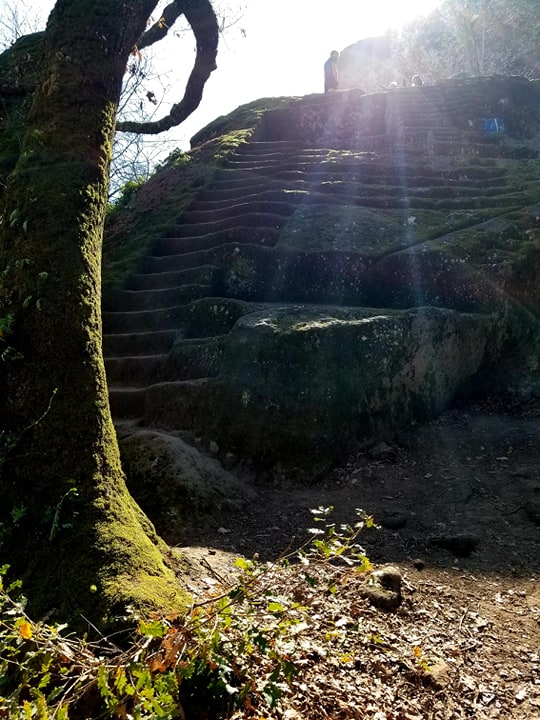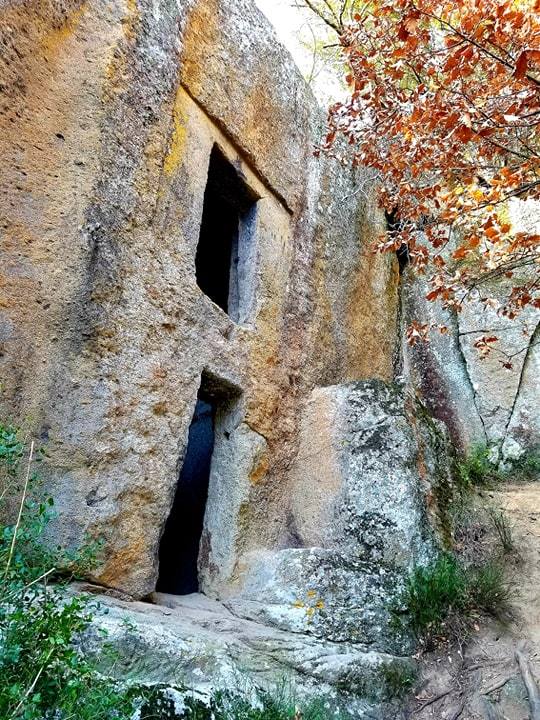ROME – “Discovery” is a difficult term. It places emphasis on the current civilization and places privilege, and even bestows power, to a specific culture. The North and South American continents were already here when Europeans arrived as were the indigenous people. No actual discovery occurred–the term actually means that a group ignorant of a specific reality was enlightened, even corrected regarding their previous knowledge.
In 1991, two researchers, Giovanni Lamoratta and Giuseppe Maiorano, reportedly discovered a stone structure in the Tacchiolo area of the small town of Bomarzo Italy about 90 minutes north of Rome in the province of Viterbo. The researchers stumbled across the monument while working the area in the spring of that year. The discovery was met with little interest. In one sense, the pyramid was lost again within a few years of its discovery. In another sense, a discovery did not occur as the area had been inhabited by individuals and families who were poor or destitute seeking shelter in the area.
In 2008, agriculturalist Salvatore Fosci was performing some surveying in the same area and re-discovered the “pyramid”. Mr. Fosci took the time to clear the structure, so its scope and location be came clearly visible. He also informed community members and local rangers about the find and its location. This time, the discovery stuck, at least in the internet and into contemporary awareness. But Mr. Fosci notes in his conversations about the re-discovery that many in the area–even from his great-grandfather’s time–may have known of the stone structure’s existence. Mr. Fosci’s initiative to make the structure visible by removing plants and debris made the structure clearly visible.

The Etruscan Pyramid from Front. Photo Credit: Stefano Ciotti
Still, the structure seemed to garner little attention. Recently, however, more and more visitors have tried to find the location of the structure raising its profile and assuring the current iteration of discovery is complete for the time being.
What is it?
The name Etruscan “pyramid” is a misnomer. The structure is not a pyramid, at least the way most of would imagine having seen images from Egypt or Mexico. Rather, the structure is a huge piece of volcanic peperino rock that was naturally and generally triangular and then carved with multiple levels. It has 26 steps hewn out of the rock that rise to the first level and the steepness of the steps echo the shape of the Mayan pyramids of Mexico. The steep stairway leads to two flattened levels that may have served as intermediate altars and the main altar at the top. The flattened levels are connected by a smaller set of stairs with a final short set to the top of the structure. There are also some carved gutters about 6 inches deep. In total, the structure is about 24ft (~8m) by 53ft (~16m) and rises to about 30ft (~10m) in height. It is the largest such structure in Europe.
What was it for?
Its purpose is somewhat unknown as archaeologists have yet to focus attention on the structure, but it appears to be an altar for offerings and is surrounded by other Etruscan ruins. At the top altar, there is an off-set area that overlooks the cliff face on which the structure sits. Some claim that human offerings were conducted here but without specific evidence, the nature of the offerings remains unknown. Etruscans, however, depicted human sacrifice in both their art and literature and recent evidence from an excavation in Tarquinia appears to affirm the practice. The altar itself faces northwest, which aligns with direction of the Etruscan underworld; and indeed the channel for any flowing liquid follows that direction until it falls over the cliff.

The Etruscan Pyramid at Bomarzo, Italy. Photo Credit: M. Tejeda-Moreno
It is also part of a complex of other structures carved into adjacent areas of the cliff. One such area, the “preacher’s stone”, reportedly contained a sarcophagus. It was part of a two-level structure carved in the cliff face near the pyramid. But again, the exact rituals constructed here and the possible roles the inhabitants had in relation to the adjacent carvings are mostly unknown or passed along as assumptions.
Etruscan Culture and Religion
Centered in the now Italian province of Tuscany whose names derives from these prior inhabitants, Etruscan civilization flourished from about 900 BCE to about 100 BCE when it was overcome and assimilated by the Roman Republic. The civilization stretched the Tyrrhenian Sea northeast to the modern Veneto region and along the Italian coast toward modern-day Naples. Their wealth and power remain attested to in their art. They were also heavily influenced by Greek culture both Archaic and Hellenistic. Their language, apparently unrelated to Indo-European, is an isolate to the region and remains incompletely understood.

Etruscan Priest Dwelling in Bomarzo, Italy. Photo Credit: Stefano Ciotti
Etruscan religion centered on Tages, a child deity who sprung from cultivated earth and revealed the religious elements to the culture. Those teachings culminate in the Etrusca Disciplina; itself heavily influencing Roman Religion. Other deities of Etruscan religion are known and appear to be indigenous, while other deities entered the religion through contact with Greece. However, sources suggest that Etruscan were immanent polytheists, with all reality and observable phenomenon connected to divine forces.
They also believed in a responsibility to feed their deities and ancestors. Like many other religions, they placed particularly importance on blood. They also appear to have practiced various types of animal augury, again lending some support to the use of the Pyramid’s altar.
If you go
The Pyramid is located in Bomarzo, Italy and is accessible to the public on foot. But, it is also located along steep cliffs in a wooded area. A local guide is helpful and advised if you do not speak Italian. You do need to have a car to get to the parking area and there does not appear to be a way to arrive using public transportation. Again, a local guide could assist. You do not need to be an avid hiker to get to the pyramid but you do need to be able to walk a couple of miles over uneven terrain and slippery locations as well as narrow ledges. The pyramid and tombs are essentially on the edge of a tall cliff. Parking is at a small area before a long and narrow dirt road. At the end of the road is the entrance to the area and from there, you must – more or less – intuit the traveled paths. There is no directional signage. The area of the pyramid has other Etruscan carvings, but, again, they are not identified by signage. Finally, yes, it is a long trip and worth it.
The Wild Hunt is not responsible for links to external content.
To join a conversation on this post:
Visit our The Wild Hunt subreddit! Point your favorite browser to https://www.reddit.com/r/The_Wild_Hunt_News/, then click “JOIN”. Make sure to click the bell, too, to be notified of new articles posted to our subreddit.
